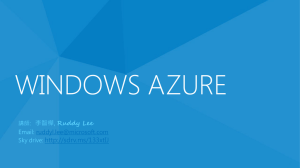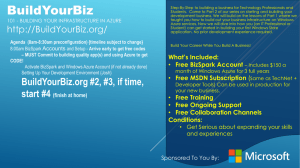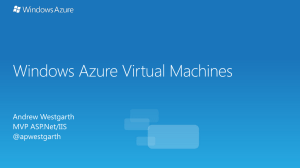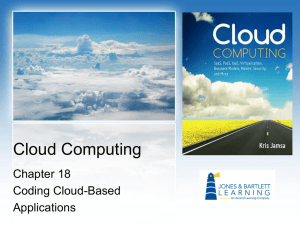Windows Azure Web Role
advertisement
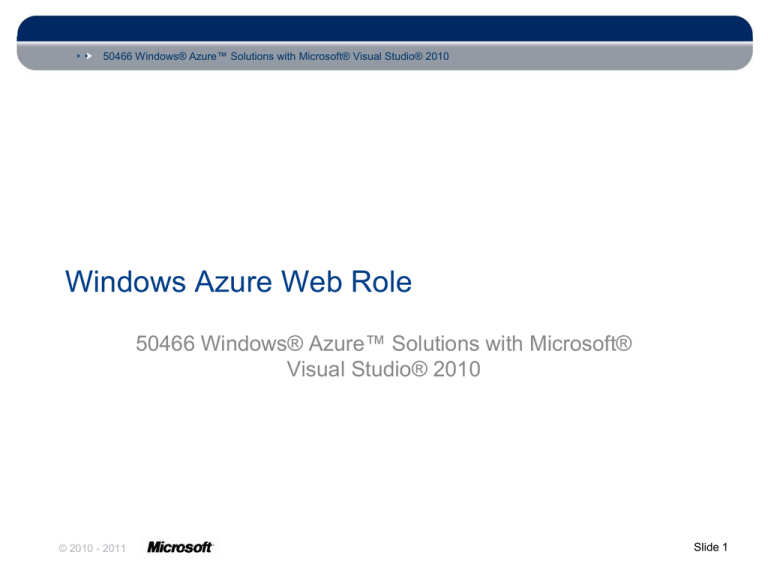
50466 Windows® Azure™ Solutions with Microsoft® Visual Studio® 2010
Windows Azure Web Role
50466 Windows® Azure™ Solutions with Microsoft®
Visual Studio® 2010
© 2010 - 2011
Slide 1
50466 Windows® Azure™ Solutions with Microsoft® Visual Studio® 2010
The Web Role
•
As mentioned in the last chapter, Windows Azure supports three types of
roles in hosted services: Web roles, worker roles and VM roles.
•
•
Web roles are the focus of this chapter.
Web roles run under Windows Azure Compute service.
•
A Web role is a Web site, Web application or Web service (Windows
Communication Foundation service) supported by IIS 7 and ASP.NET in the
cloud.
© 2010 - 2011
Slide 2
50466 Windows® Azure™ Solutions with Microsoft® Visual Studio® 2010
The Web Role Cont.
•
Windows Azure Tools (WAT) for VS provides four Web role templates as
specified in table below.
Web Role Type
Description
ASP.NET Web Role
General Web application that talks HTTP/HTTPS, runs on IIS 7, and the
ASP.NET stack. Essentially the same as an ASP.NET Web Application
template, but built to run in the Windows Azure cloud.
ASP.NET MVC 2 Web Role
A Web application that talks HTTP/HTTPS, runs on IIS 7, but is prewired to
support the MVC 2 Framework. Essentially the same as an ASP.NET MVC 2
Web Application, but built to run in the Windows Azure cloud.
WCF Service Web Role
A Windows Communication Foundation (WCF) service hosted in IIS with
HTTP or HTTPS endpoints. Essentially the same as WCF Service
Application template, but built to run in the Windows Azure cloud.
CGI Web Role
Host a FastCGI protocol project. This allows Web sites written in languages
such as PHP or Python to run in Windows Azure.
© 2010 - 2011
Slide 3
50466 Windows® Azure™ Solutions with Microsoft® Visual Studio® 2010
The Web Role Cont.
•
•
•
•
You can use either Visual C# or Visual Basic to write Web roles (or any
Windows Azure service).
When you request a new Windows Azure project in VS, Windows Azure
prompts you to add any of these Web roles to your solution.
You may add any number of each role to the Windows Azure project.
You can change the name of the role once selected to be part of the
project.
© 2010 - 2011
Slide 4
50466 Windows® Azure™ Solutions with Microsoft® Visual Studio® 2010
The Web Role Cont.
•
If you have an existing Windows Azure project, you can add new roles to
your project.
•
Right click on the Windows Azure project and VS displays a menu that allows
you to add new Web or worker roles to the project.
•
When selecting to add a Web Role, VS provides a similar Web role selectionprompt for choosing the Web role type to add.
© 2010 - 2011
Slide 5
50466 Windows® Azure™ Solutions with Microsoft® Visual Studio® 2010
The Web Role Cont.
•
Please note (particularly for WCF services), Windows Azure limits inbound
traffic to HTTP or HTTPS.
•
•
•
Outbound traffic can use TCP sockets.
Windows Azure does not support UDP at this time.
Web roles run inside or (are hosted in) Internet Information Services (IIS)
7.
•
•
•
•
As of Windows Azure SDK 1.3, Web roles have full IIS 7 support.
Prior to Windows Azure SDK 1.3, Web roles ran in an IIS Hosted Web Core.
The IIS Hosted Web Core had the same pipeline as IIS, but with a few
restrictions.
Importantly, this means Azure now supports multiple Web sites in your Web
roles.
Azure now also supports activation of WCF services over non-HTTP transports
through Windows Activation Services.
© 2010 - 2011
Slide 6
50466 Windows® Azure™ Solutions with Microsoft® Visual Studio® 2010
The Web Role Cont.
•
When you request a Web role, the Fabric Controller configures virtual
machines with an image containing IIS 7 and deploys your application
within IIS 7.
•
•
Web roles are heavily dependent on the features built into IIS 7.
Because Windows XP (and other older operating systems) only supports older
versions of IIS, the Windows Azure SDK doesn't run on Windows XP.
© 2010 - 2011
Slide 7
50466 Windows® Azure™ Solutions with Microsoft® Visual Studio® 2010
Exploring the Web Role Project
•
Once you create a new Windows Azure project, VS creates a solution that
includes a cloud project along with a project for each role you requested.
•
For example, in the Hello World project from the last chapter, notice the
HelloWorldWebRole project along with the HelloWorld cloud project.
•
Details on the cloud project are forthcoming. Before looking at the cloud
project, let’s explore the Web role project.
© 2010 - 2011
Slide 8
50466 Windows® Azure™ Solutions with Microsoft® Visual Studio® 2010
Exploring the Web Role Project Cont.
•
A Web role project looks nearly identical to non-Azure Web project.
•
•
•
In other words, an ASP.NET Web role project looks almost identical to an
ASP.NET Web Application project.
A WCF Service Application looks almost identical to a WCF Service Web role.
For example, below are the default contents of a standard ASP.NET Web
Application and ASP.NET Web Role project as produced by VS.
© 2010 - 2011
Slide 9
50466 Windows® Azure™ Solutions with Microsoft® Visual Studio® 2010
Exploring the Web Role Project Cont.
•
•
•
The “normal” Web application project is shown on the left while a Web role
project is shown on the right. Notice much difference?
In fact, the only difference is that the Web role adds 3 Windows Azure
references and the WebRole.cs file.
Below is a similar comparison of a normal WCF Service Application project
and a WCF Service Web role project. Again, not much difference.
© 2010 - 2011
Slide 10
50466 Windows® Azure™ Solutions with Microsoft® Visual Studio® 2010
Exploring the Web Role Project Cont.
•
Web role projects, created by using the cloud templates provided through
WAT, include references to three Windows Azure namespaces listed in the
table below.
Namespace
Description
Microsoft.WindowsAzure.Diagnostics
Classes for collecting logs and diagnostic information
Microsoft.WindowsAzure.ServiceRunti
me
Classes that allow you to interact with the Windows Azure environment
Microsoft.WindowsAzure.StorageClient
A client library for working with the Windows Azure storage services
•
•
•
You explore the classes of these namespaces later, starting with the
ServiceRuntime package in this chapter.
While quite frequently used, the other two namespaces (Diagnostics and
StorageClient) are optional.
That is, diagnostics/logging and the use of Windows Azure Storage are not
required by each role.
© 2010 - 2011
Slide 11
50466 Windows® Azure™ Solutions with Microsoft® Visual Studio® 2010
Exploring the Web Role Project Cont.
•
The WebRole.cs class extends the RoleEntryPoint class from the
Microsoft.WindowsAzure.ServiceRuntime namespace.
•
•
•
RoleEntryPoint provides callbacks to initialize, run, and stop instances of a role.
In this way, the WebRole.cs file acts like a Global.asax file in a traditional
ASP.NET application.
The Windows Azure platform calls the OnStart() method after loading the Web
role assembly and starting the role.
public override bool OnStart()
{
// For information on handling configuration changes
// see the MSDN topic at
// http://go.microsoft.com/fwlink/?LinkId=166357.
return base.OnStart();
}
© 2010 - 2011
Slide 12
50466 Windows® Azure™ Solutions with Microsoft® Visual Studio® 2010
Exploring the Web Role Project Cont.
•
•
The method returns true if initialization of the role succeeded.
Of course, you can add your own code to the OnStart() method to further
initialize your Web role for your application needs.
•
•
In particular, a comment in the role points developers to an MSDN post for how
to use the method to establish an event listener for handling configuration
changes.
You learn more about the configuration of Windows Azure roles (how and why
you change them at runtime) later in this chapter.
© 2010 - 2011
Slide 13
50466 Windows® Azure™ Solutions with Microsoft® Visual Studio® 2010
Exploring the Web Role Project Cont.
•
By default, the WebRole.cs does not provide an overridden OnStop()
method.
•
•
However, you may want to add an override the OnStop() method.
Add an OnStop() method to WebRole.cs when you want to do clean up of
resources used by the role when the Web role is stopped.
public override void OnStop()
{
// clean up resources
}
© 2010 - 2011
Slide 14
50466 Windows® Azure™ Solutions with Microsoft® Visual Studio® 2010
Exploring the Windows Azure Project
•
The Windows Azure project created during the formation of the solution is
a container and the configuration for all the roles in the project.
•
•
When you create a Windows Azure project, a Roles subdirectory lists each of
the Windows Azure roles that are part of the project.
As shown in the exaggerated example below, this cloud service has two of each
type of Web role. Each of the Web roles is listed in the Roles subdirectory.
© 2010 - 2011
Slide 15
50466 Windows® Azure™ Solutions with Microsoft® Visual Studio® 2010
Exploring the Windows Azure Project Cont.
•
Each Windows Azure project also has two very important files: the service
definition file and service configuration file.
•
•
•
•
•
•
ServiceDefinition.csdef is the default name of service definition file.
ServiceConfiguration.cscfg is the default name of the service configuration file.
These XML files define the configuration for all the roles in the cloud service.
These files define what many call the Service Model of your service.
The Fabric Controller uses the information in these files to determine how to
deploy and operate your application in the Fabric.
The service definition and service configuration files are related, but each
has a specific and different purpose.
© 2010 - 2011
Slide 16
50466 Windows® Azure™ Solutions with Microsoft® Visual Studio® 2010
Exploring the Windows Azure Project Cont.
•
The service definition file defines the roles and overall structure of your
service.
•
•
•
•
In particular, it defines the size of the virtual machine required to support each
role, whether a role requires native code execution, and the ports roles listen
on.
The service definition file is also used to configure your web role to support
multiple web sites and web applications.
The service definition file also defines configuration settings (i.e. configuration
parameters or environmental variables) used by the application.
However, the service definition file does not provide the values for the
configuration settings.
© 2010 - 2011
Slide 17
50466 Windows® Azure™ Solutions with Microsoft® Visual Studio® 2010
Exploring the Windows Azure Project Cont.
•
Importantly, definitions in the service definition file cannot change at
runtime!
•
•
•
•
The service definition file is part of your application’s cloud service package.
You may recall from the last chapter that the cloud service package file ended
with a .cspkg extension.
To change the service definition, you must deploy a new cloud service package.
This means you must stop the service, provide a new/updated service
definition, and then restart the service.
© 2010 - 2011
Slide 18
50466 Windows® Azure™ Solutions with Microsoft® Visual Studio® 2010
Exploring the Windows Azure Project Cont.
•
The service configuration file defines values for configuration that can
change at runtime.
•
•
•
•
The service configuration file defines the values for all configuration parameters
defined in the service definition file.
The service configuration file also defines the number of instances (i.e. the
number of virtual machines) required for each role.
You might recall from the last chapter, when you publish an application into the
cloud, you must provide the Developer Portal with the service configuration file.
The service configuration file ends with a .cscfg file extension.
© 2010 - 2011
Slide 19
50466 Windows® Azure™ Solutions with Microsoft® Visual Studio® 2010
Exploring the Windows Azure Project Cont.
•
So, the key difference between the service definition and service
configuration file is change.
•
•
•
The service definition file is static at runtime; defining the infrastructure and
operational behavior of the service.
The service configuration file expands on the definitions of the service definition
by specifying current configuration values that can be modified at runtime.
For example, you may need to change the database connection string (which
might be different for staging versus production) in the runtime environment.
© 2010 - 2011
Slide 20
50466 Windows® Azure™ Solutions with Microsoft® Visual Studio® 2010
Exploring the Windows Azure Project Cont.
•
The Windows Azure Developer Portal and Service Management API
provide mechanisms for changing the service configuration file for running
services.
•
When you request to change the configuration through the Portal, you can
choose to upload a new service configuration file (.cscfg file).
© 2010 - 2011
Slide 21
50466 Windows® Azure™ Solutions with Microsoft® Visual Studio® 2010
Exploring the Windows Azure Project Cont.
•
•
Alternatively, you can request to edit the deployed configuration file with an
editor provided by the Portal.
In development, you may manually enter the XML metadata and
configuration specified in the service definition and service configuration
files.
•
•
•
A schema dictates the structure of information in both files. Therefore, VS
provides intellisense for editing.
You can find a complete schema reference for both the service definition and
service configuration here: msdn.microsoft.com/en-us/library/dd179398.aspx.
However, manual entry tends to be a messy, labor intensive, and error prone
way of defining the structure and configuration values of your service.
© 2010 - 2011
Slide 22
50466 Windows® Azure™ Solutions with Microsoft® Visual Studio® 2010
Exploring the Windows Azure Project Cont.
•
As a preferred option, use a dialog box GUI provided as part of the
Windows Azure Tools for VS to enter configuration into the files.
•
To access the GUI editor for the service definition and configuration files,
double click on any of the roles listed in the Roles subdirectory of the Windows
Azure project.
© 2010 - 2011
Slide 23
50466 Windows® Azure™ Solutions with Microsoft® Visual Studio® 2010
Exploring the Windows Azure Project Cont.
•
•
•
•
Note that the GUI dialog box somewhat obfuscates whether you are entering
service definition or service configuration information.
Further, double clicking on each role brings up a separate GUI dialog box that
allows you to define configuration for that role.
This almost makes it seem like there are multiple configuration files.
However, when you save the data via the GUI, it all gets turned into XML and
stored appropriately in the single service definition and configuration files.
© 2010 - 2011
Slide 24
50466 Windows® Azure™ Solutions with Microsoft® Visual Studio® 2010
Reacting to Configuration Change
•
At runtime, when a service configuration setting changes, Windows Azure
throws RoleEnvironment.Changing and .Changed events.
•
•
•
•
The Changing event occurs before the configuration change is applied to an
instance of a role.
The Changed event occurs after the configuration change is applied to an
instance of a role.
You can find both of these events in Microsoft.WindowsAzure.ServiceRuntime.
These events allow the roles to detect a configuration change and restart
themselves with the new option(s).
© 2010 - 2011
Slide 25
50466 Windows® Azure™ Solutions with Microsoft® Visual Studio® 2010
Reacting to Configuration Change Cont.
•
Many developers use the WebRole.cs OnStart() method to register a
callback method to react to the Changing event.
public override bool OnStart()
{
RoleEnvironment.Changing += RoleEnvironmentChanging;
return base.OnStart();
}
Public Overrides Function OnStart() As Boolean
RoleEnvironment.Changing = (RoleEnvironment.Changing +
RoleEnvironmentChanging)
Return MyBase.OnStart()
End Function
© 2010 - 2011
Slide 26
50466 Windows® Azure™ Solutions with Microsoft® Visual Studio® 2010
Reacting to Configuration Change Cont.
•
Here is an implementation of the RoleEnvironmentChanging method
(added to WebRole.cs) that would react to a change in the service
configuration.
© 2010 - 2011
Slide 27
50466 Windows® Azure™ Solutions with Microsoft® Visual Studio® 2010
Reacting to Configuration Change Cont.
private void RoleEnvironmentChanging(object sender, RoleEnvironmentChangingEventArgs e)
{
// Add code for handling changes
// If a configuration setting is changing
if (e.Changes.Any(change => change is
RoleEnvironmentConfigurationSettingChange))
{
// Set e.Cancel to true to restart this role instance
e.Cancel = true;
}
}
Private Sub RoleEnvironmentChanging(ByVal sender As Object, ByVal e As
RoleEnvironmentChangingEventArgs)
' Add code for handling changes
' If a configuration setting is changing
If e.Changes.Any(change=, Greater, (TypeOf change Is
RoleEnvironmentConfigurationSettingChange)) Then
' Set e.Cancel to true to restart this role instance
e.Cancel = true
End If
End Sub
© 2010 - 2011
Slide 28
50466 Windows® Azure™ Solutions with Microsoft® Visual Studio® 2010
Reacting to Configuration Change Cont.
•
•
In this case, the method just checks to see if a configuration setting has been
changed, and if so, restarts the role to include the change.
The RoleEnvironmentChangingEventArgs object passed in provides a
Changes property.
•
•
This property provides you a collection of the configuration changes that are
about to be applied to the role instance.
See msdn.microsoft.com/en-us/library/gg433017.aspx for more details on the
events and how to use them.
© 2010 - 2011
Slide 29
50466 Windows® Azure™ Solutions with Microsoft® Visual Studio® 2010
Web Role Configuration
•
There are many configuration elements and setting options for Web roles.
•
•
•
•
Most of the configuration elements are the same for worker roles. You examine
configuration elements unique to worker roles in the worker role chapter.
The VS GUI editor for configuration provides six tabs (Configuration, Settings,
Endpoints, Local Storage, Certificates and Virtual Network) for specifying
settings.
These tabs provide a good way to explore role configuration.
The VS GUI editor for configuration can be obtained by selecting Properties on
the role reference in the Solution Explorer.
© 2010 - 2011
Slide 30
50466 Windows® Azure™ Solutions with Microsoft® Visual Studio® 2010
Web Role Configuration Cont.
•
On the Configuration tab are two of the more important configuration
settings for any role: instances count and VM size.
•
•
The instance count (defaults to 1) allows you to specify the number of role
instances (i.e. virtual machines) you want running in the cloud.
Running in Windows Azure Compute, role instances are often called compute
instances.
© 2010 - 2011
Slide 31
50466 Windows® Azure™ Solutions with Microsoft® Visual Studio® 2010
Web Role Configuration Cont.
•
The VM size determines the size of the physical hardware used and virtual
machine created to host your service.
•
•
The Web role and the VM size is defined in the service definition file, while the
number of instances is stored in the service configuration file.
What does this tell you about what can change at runtime?
© 2010 - 2011
Slide 32
50466 Windows® Azure™ Solutions with Microsoft® Visual Studio® 2010
Web Role Configuration Cont.
<?xml version="1.0" encoding="utf-8"?>
<ServiceConfiguration serviceName="HelloWorld" xmlns="http://schemas.microsoft.com/ServiceHosting/2008/10/ServiceConfiguration"
osFamily="1" osVersion="*">
<Role name="HelloWorldWebRole">
<Instances count="1" />
<ConfigurationSettings>
<Setting name=
"Microsoft.WindowsAzure.Plugins.Diagnostics.ConnectionString"
value="UseDevelopmentStorage=true" />
</ConfigurationSettings>
</Role>
</ServiceConfiguration>
<ServiceDefinition name="HelloWorld" xmlns="http://schemas.microsoft.com/ServiceHosting/2008/10/ServiceDefinition">
<WebRole name="HelloWorldWebRole" vmsize="Small">
<Sites>
<Site name="Web">
<Bindings>
<Binding name="Endpoint1" endpointName="Endpoint1" />
</Bindings>
</Site>
</Sites>
<Endpoints>
<InputEndpoint name="Endpoint1" protocol="http" port="80" />
</Endpoints>
<Imports>
<Import moduleName="Diagnostics" />
</Imports>
</WebRole>
</ServiceDefinition>
Slide 33
© 2010 - 2011
50466 Windows® Azure™ Solutions with Microsoft® Visual Studio® 2010
Web Role Configuration Cont.
•
Once deployed, Windows Azure provides automatic load balancing for
Web roles that have two or more instances.
•
•
•
•
•
•
During the deployment process, the FC sees the number of instances specified
in your configuration file.
It then allocates and configures load balancing for your service.
How does this work? When deploying your application, the FC requests a DNS
entry that maps your service URL to a virtual IP address (VIP).
Internal to the data center, each role instance has an internal-only IP address
called the direct IP address (DIP).
The FC also informs load balancers to redirect any request at the VIP to the
DIP.
Load balancers work on a simple round-robin algorithm.
© 2010 - 2011
Slide 34
50466 Windows® Azure™ Solutions with Microsoft® Visual Studio® 2010
Web Role Configuration Cont.
•
It is because of the VIP and DIP that the FC is able to quickly move your
services from Staging to Production as discussed in the last chapter.
•
•
When you “move” your application from Staging to Production, no code really
moves.
Instead, the FC just informs DNS and the load balancers that the URL you
selected is now the URL for the VIP.
© 2010 - 2011
Slide 35
50466 Windows® Azure™ Solutions with Microsoft® Visual Studio® 2010
Web Role Configuration Cont.
•
An important point to be made here is that while automatic failover is
provided by Windows Azure, automatic scale out is not!
•
•
•
•
If an instance dies, the FC tries to recover the instance and automatically
reestablishes the failed instances on a new virtual machine if it cannot restart it.
If you need more instances to address a Slashdot effect upon your Web role,
for example, you must add them through a configuration update.
Windows Azure does not scale automatically.
Either through manual detection and intervention or via sophisticated service
management code, you must handle the scale out (and down) of your
instances.
© 2010 - 2011
Slide 36
50466 Windows® Azure™ Solutions with Microsoft® Visual Studio® 2010
Web Role Configuration Cont.
•
The VM Size determines how much of a physical server is dedicated to the
virtual machine running each of the instances of your role.
•
•
•
•
The VM Size cannot change at runtime. Therefore, in order to avoid service
stops and upgrades, it is important to get the right size VM for your instances.
The virtual machine also affects cost. The larger the virtual machine, the higher
the cost.
Virtual machines range in extra small to extra large. Small is the default VM
size.
The table below shows the number of CPU cores, amount of memory, and
allotted local disk space dedicated to each of the VM sizes.
© 2010 - 2011
Slide 37
50466 Windows® Azure™ Solutions with Microsoft® Visual Studio® 2010
Web Role Configuration Cont.
VM Size
CPU cores
Available Memory
Allotted Local Disk Space
Extra Small
Shared
768 MB
20 GB
Small
1
1.75 GB
225 GB
Medium
2
3.5 GB
490 GB
Large
4
7.0 GB
1,000 GB
Extra Large
8
14 GB
2,040 GB
•
•
Assigning an extra large VM to your instances is essentially requesting the FC
to allocate an entire physical server to your role.
At this time, the VM size must be the same for all instances of one role.
Different roles can have different size VMs.
© 2010 - 2011
Slide 38
50466 Windows® Azure™ Solutions with Microsoft® Visual Studio® 2010
Web Role Configuration Cont.
•
The extra small VM was added to Azure with Windows Azure SDK 1.3.
•
•
•
•
Therefore, this size VM is not available when using early versions of the
Windows Azure SDK.
While the extra small instance may serve the needs of some tiny applications,
the real purpose of extra small VMs is to assist developers.
Extra small VMs allows more people to test drive Azure.
The extra small VM should:
"make the process of development, testing and trial easier for enterprise
developers. The Extra Small instance will also make Windows Azure more
affordable for developers interested in running smaller applications on the platform."
© 2010 - 2011
Slide 39
50466 Windows® Azure™ Solutions with Microsoft® Visual Studio® 2010
Web Role Configuration Cont.
•
Additionally, according to Microsoft, you can expect small VMs will have
“medium” I/O performance compared to that of other sized VM’s.
•
•
This is because larger VMs get a larger allocation of the shared resources in the
cloud.
According to Microsoft documentation, “having a larger allocation of the shared
resource will also result in more consistent I/O performance.”
© 2010 - 2011
Slide 40
50466 Windows® Azure™ Solutions with Microsoft® Visual Studio® 2010
Web Role Configuration Cont.
•
Remember, in the cloud, you pay for what you use! More precisely, you
pay for what you allocate.
•
•
•
Picking the number of instances for your role and the size of the virtual
machine, really affects how much of the cloud you use.
The table below specifies the cost per compute instance for each of the VM
sizes at the time of this writing (Under the Pay-as-you-go plan).
VM Size
Cost per instance per hour in Windows Azure Compute
Extra Small
$0.05
Small
$0.12
Medium
$0.24
Large
$0.48
Extra Large
$0.96
Please note that partial compute instance hours are billed as full compute
hours.
© 2010 - 2011
Slide 41
50466 Windows® Azure™ Solutions with Microsoft® Visual Studio® 2010
Web Role Configuration Cont.
•
•
•
•
Carefully experiment and plan the number of instances and VM size you need.
Consider and weigh scale and redundancy/failover versus costs.
You might find, for example, a single extra large instance can handle the needs
of several smaller instances; thereby reducing the overall cost of your hosted
service.
Additional costs (covered later in class) are incurred for data storage,
transactions, etc. that you use.
•
•
Microsoft offers additional pricing plans for those that have larger volume
needs.
For details and the latest costs associated with Windows Azure, always consult
the Windows Azure Platform pricing Web site:
www.microsoft.com/windowsazure/pricing/.
© 2010 - 2011
Slide 42
50466 Windows® Azure™ Solutions with Microsoft® Visual Studio® 2010
Web Role Configuration Cont.
•
In order to qualify for the Windows Azure Service Level Agreement (SLA),
any role you have deployed to Azure must have at least two instances.
•
•
When you deploy your service to Azure, you are warned if your service
configuration does not specify at least two instances for every role.
You might recall from your lab associated to the last chapter that the Portal
warned you that the HelloWorld service had only one Web role instance.
© 2010 - 2011
Slide 43
50466 Windows® Azure™ Solutions with Microsoft® Visual Studio® 2010
Web Role Configuration Cont.
•
The trust level specifies privileges the role has to access certain machine
resources and execute native code.
•
Your selection sets the enableNativeCodeExecution attribute of the role in the
service definition file.
<WebRole name="HelloWorldWebRole" enableNativeCodeExecution="true">
...
</WebRole>
•
•
The default value is Full trust enabled (making the enableNativeCodeExecution
attribute not required in the service definition file).
Windows Azure roles run under a user context and never as administrators.
Therefore, access to the underlying server (physical or virtual) is limited.
© 2010 - 2011
Slide 44
50466 Windows® Azure™ Solutions with Microsoft® Visual Studio® 2010
Web Role Configuration Cont.
•
•
•
However, when the trust level is set to Full trust (the default), the role has
access to certain machine resources (like system registries) and can execute
native code.
Native code might include executing unmanaged C++ code, or calling a Win32
DLL with P/Invoke.
Running other native processes is very important to support additional
languages (such as Java) on Windows Azure.
© 2010 - 2011
Slide 45
50466 Windows® Azure™ Solutions with Microsoft® Visual Studio® 2010
Web Role Configuration Cont.
•
Under partial trust, the role cannot access machine resources and cannot
execute native code.
•
•
•
•
Under partial trust, code cannot connect to external IP addresses over TCP and
can only access files/folders in its local storage.
Partial trust is very similar to ASP.NET's medium trust level.
While partial trust is very restrictive, it also helps to secure your role by default.
Hackers working on a Web site running under partial trust would find accessing
anything very difficult.
© 2010 - 2011
Slide 46
50466 Windows® Azure™ Solutions with Microsoft® Visual Studio® 2010
Web Role Configuration Cont.
•
The startup action is a configuration setting for testing/debugging in VS
only and has no applicability to the way the role behaves or runs in the
cloud.
•
•
•
•
This setting only applies to Web roles.
In fact, this one configuration option is not saved in either the service
configuration or service definition file.
The two check boxes determine which endpoint (HTTP or HTTPS) is used by
the browser(s) that are launched using the Compute Emulator.
The HTTPS option is only available if you enable your role for HTTPS endpoints
(covered below).
© 2010 - 2011
Slide 47
50466 Windows® Azure™ Solutions with Microsoft® Visual Studio® 2010
Web Role Configuration Cont.
•
Lastly, on the Configuration tab you have the ability to enable/disable
Diagnostics.
•
•
•
By default, Diagnostics are enabled. This setting tells Windows Azure whether
to capture diagnostic/log data and where to store it if captured.
By default, diagnostic/log data is captured locally in the Storage Emulator of
your system.
You learn more about diagnostic data and this setting in a later chapter.
© 2010 - 2011
Slide 48
50466 Windows® Azure™ Solutions with Microsoft® Visual Studio® 2010
Web Role Configuration Cont.
•
The Settings tab allows you to define configuration settings that are
accessible from the role code.
•
•
•
Configuration settings are key-value pairs that may identify resources, provide
indicators for conditionalized code, or otherwise provide a config value to the
role.
The same kind of idea is available via appSettings in app.config or web.config in
ASP.NET applications.
You can add (and remove) settings in this tab and specify them as simple
name-value strings or specify them as connection strings pointing to some
resource.
© 2010 - 2011
Slide 49
50466 Windows® Azure™ Solutions with Microsoft® Visual Studio® 2010
Web Role Configuration Cont.
•
In fact, under the covers, enabling Diagnostics (mentioned above) is
defined by a
Microsoft.WindowsAzure.Plugins.Diagnostics.ConnectionString setting.
•
When you enable Diagnostics, the
Microsoft.WindowsAzure.Plugins.Diagnostics.ConnectionString setting is
defined.
•
When you disable Diagnostics, this setting is removed.
© 2010 - 2011
Slide 50
50466 Windows® Azure™ Solutions with Microsoft® Visual Studio® 2010
Web Role Configuration Cont.
•
Custom settings you define in the Settings tab show up as elements in
both the service definition and service configuration files.
•
When you create a new custom setting, it shows up as a setting under
<ConfigurationSettings> in the service definition file.
© 2010 - 2011
Slide 51
50466 Windows® Azure™ Solutions with Microsoft® Visual Studio® 2010
Web Role Configuration Cont.
<ServiceDefinition name="HelloWorld"
xmlns="http://schemas.microsoft.com/ServiceHosting/2008/10/ServiceDefinition">
<WebRole name="HelloWorldWebRole" vmsize="Small">
<Sites>
<Site name="Web">
<Bindings>
<Binding name="Endpoint1" endpointName="Endpoint1" />
</Bindings>
</Site>
</Sites>
<Endpoints>
<InputEndpoint name="Endpoint1" protocol="http" port="80" />
</Endpoints>
<Imports><Import moduleName="Diagnostics" /></Imports>
<ConfigurationSettings>
<Setting name="HelloWorldGreeting" />
</ConfigurationSettings>
</WebRole>
Slide 52
© 2010 - 2011
</ServiceDefinition>
50466 Windows® Azure™ Solutions with Microsoft® Visual Studio® 2010
Web Role Configuration Cont.
•
It is also present in the service configuration file. In the configuration file, the
actual value for the custom setting is also specified.
<ServiceConfiguration serviceName="HelloWorld"
xmlns="http://schemas.microsoft.com/ServiceHosting/2008/10/ServiceConfiguration
" osFamily="1" osVersion="*">
<Role name="HelloWorldWebRole">
<Instances count="1" />
<ConfigurationSettings>
<Setting name=
"Microsoft.WindowsAzure.Plugins.Diagnostics.ConnectionString"
value="UseDevelopmentStorage=true" />
<Setting name="HelloWorldGreeting" value="Hello Class" />
</ConfigurationSettings>
</Role>
</ServiceConfiguration>
© 2010 - 2011
Slide 53
50466 Windows® Azure™ Solutions with Microsoft® Visual Studio® 2010
Web Role Configuration Cont.
•
•
What is the reason for this arrangement? Remember again, the service
definition file remains static at runtime while the service configuration settings
are dynamic.
So, this arrangement allows you to change the values of custom settings, but
you cannot add or remove settings at runtime.
© 2010 - 2011
Slide 54
50466 Windows® Azure™ Solutions with Microsoft® Visual Studio® 2010
Web Role Configuration Cont.
•
To access any custom setting, use the RoleEnvironment class in the
Microsoft.WindowsAzure.ServiceRuntime namespace.
•
•
This class represents the Windows Azure environment to the application code.
Call on the GetConfigurationSettingValue( ) method to access the value for any
of the name-value custom setting pairs.
protected void Page_Load(object sender, EventArgs e)
{
WelcomeLabel.Text =
RoleEnvironment.GetConfigurationSettingValue("HelloWorldGreeting");
}
Protected Sub Page_Load(ByVal sender As Object, ByVal e As System.EventArgs)
Handles Me.Load
Me.PageTitleLabel.Text =
RoleEnvironment.GetConfigurationSettingValue("GameTitle")
End Sub
© 2010 - 2011
Slide 55
50466 Windows® Azure™ Solutions with Microsoft® Visual Studio® 2010
Web Role Configuration Cont.
•
As you may recall in the last chapter, when you deploy your application to
Windows Azure, you select the URL for your service.
•
•
•
•
The Endpoints tab, however, allows you to specify the protocol and ports of
your service endpoints.
By default, your Web role had defined one Input, HTTP endpoint operating at
port 80 publicly.
Input endpoints are used to contact the service (from outside of your
application).
Internal endpoints are used by roles to communicate with each other (from
inside your application).
© 2010 - 2011
Slide 56
50466 Windows® Azure™ Solutions with Microsoft® Visual Studio® 2010
Web Role Configuration Cont.
•
Roles (both Web and worker) can have both internal and input endpoints.
•
•
•
•
•
•
•
When specifying details about an endpoint, you can dictate the protocol (HTTP
by default, HTTPS, or TCP) used when communicating with the role.
When using HTTPS, you must also specify the name of the SSL certificate used
to secure the communications.
Certificates are specified in the Certificates tab (see below).
Internal endpoints are only accessible to other roles within the cloud service.
Therefore, they cannot be secured with certificates.
Typically, public facing ports are set to 80 and 443 for HTTP and HTTPS
respectively.
You can also optionally provide an explicit port for internal endpoints which are
also known as a local endpoints (again – only to be used internally within
Azure).
If you elect not to provide a private port, the Fabric assigns the internal port
number at run time.
© 2010 - 2011
Slide 57
50466 Windows® Azure™ Solutions with Microsoft® Visual Studio® 2010
Web Role Configuration Cont.
•
The non-dynamic service definition file stores all endpoint configurations.
© 2010 - 2011
Slide 58
50466 Windows® Azure™ Solutions with Microsoft® Visual Studio® 2010
Web Role Configuration Cont.
<ServiceDefinition name="HelloWorld"
xmlns="http://schemas.microsoft.com/ServiceHosting/2008/10/ServiceDefinition">
<WebRole name="HelloWorldWebRole">
<Sites>
<Site name="Web">
<Bindings>
<Binding name="Endpoint1" endpointName="HttpIn" />
<Binding name="Endpoint2" endpointName="HttpsIn" />
<Binding name="Endpoint1" endpointName="HttpLocal" />
</Bindings>
</Site>
</Sites>
<Endpoints>
<InputEndpoint name="HttpIn" protocol="http" port="80" />
<InputEndpoint name="HttpsIn" protocol="https" port="443"
certificate="Certificate1" />
<InternalEndpoint name="HttpLocal" protocol="http" />
</Endpoints>
<Imports>
<Import moduleName="Diagnostics" />
</Imports>
<Certificates>
<Certificate name="Certificate1" storeLocation="LocalMachine" storeName="CA" />
</Certificates>
</WebRole>
</ServiceDefinition>
© 2010 - 2011
Slide 59
50466 Windows® Azure™ Solutions with Microsoft® Visual Studio® 2010
Web Role Configuration Cont.
•
You learn about Local Storage configuration, as specified in the Local
Storage tab, in a later chapter.
•
The Certificates tab provides a means to manage digital certificates
(X.509) used for encrypting HTTPS role endpoints or custom messages.
•
•
•
•
This tab allows you to name certificates used in both Compute Emulator and the
Windows Azure cloud environments.
However, the actual certificates specified in the tab are only used in developing
and testing your application (in the Compute Emulator).
Certificates must be uploaded to Windows Azure for use in the cloud.
You upload certificates into the cloud via the Developer Portal or Service
Management API.
© 2010 - 2011
Slide 60
50466 Windows® Azure™ Solutions with Microsoft® Visual Studio® 2010
Web Role Configuration Cont.
•
Adding a certificate to be used in development and testing requires you
specify a name, location, store name, and the actual certificate.
•
•
•
The location is either LocalMachine or CurrentUser.
Select the store name from the list of My, Root, CA, or Trust, TrustedPeople, or
Disallowed.
As for the certificate, you can either enter the thumbnail manually or select a
certificate from your personal store.
© 2010 - 2011
Slide 61
50466 Windows® Azure™ Solutions with Microsoft® Visual Studio® 2010
Web Role Configuration Cont.
•
Certificate configuration is stored in both the service definition and service
configuration files.
•
The service definition file specifies the name and location of a certificate used
by the service.
<WebRole name="HelloWorldWebRole" vmsize="Small">
...
<Certificates>
<Certificate name="Certificate1" storeLocation="LocalMachine"
storeName="CA" />
<Certificate name="MessageCert" storeLocation="CurrentUser"
storeName="Root" />
</Certificates>
</WebRole>
•
However, the service configuration file details the thumbprint and algorithm of
the certificate.
© 2010 - 2011
Slide 62
50466 Windows® Azure™ Solutions with Microsoft® Visual Studio® 2010
Web Role Configuration Cont.
<Role name="HelloWorldWebRole">
...
<Certificates>
<Certificate name="Certificate1"
thumbprint="XXXXXXXXXXXXXXXXXXXXXXXXX791474723365"
thumbprintAlgorithm="sha1" />
<Certificate name="MessageCert" thumbprint=""
thumbprintAlgorithm="sha1" />
</Certificates>
</Role>
•
This allows the name of the certificate to be referenced in code, while the actual
certificate can be dynamically set.
© 2010 - 2011
Slide 63
50466 Windows® Azure™ Solutions with Microsoft® Visual Studio® 2010
Web Role Configuration Cont.
•
If using HTTPS for an endpoint on a Web role, don’t forget that the
certificate name must be referenced in the endpoint configuration.
© 2010 - 2011
Slide 64
50466 Windows® Azure™ Solutions with Microsoft® Visual Studio® 2010
Web Role Configuration Cont.
•
The last configuration tab (Virtual Networking tab) is for activating and
configuring your role for Windows Azure Connect.
•
•
•
•
•
•
Windows Azure Connect was previously known as project Sydney.
Azure Connect allows you to set up secure, IP-level network connectivity
between your roles and local (on-premises) resources.
In order to connect your role to other resources, you need to establish an
activation token via the Windows Azure Developer Portal.
You use that token on this configuration page to allow your role to connect and
communicate with other resources.
Windows Azure Connect is beyond the scope of this class.
For more information on Windows Azure Connect see msdn.microsoft.com/enus/library/gg432997.aspx.
© 2010 - 2011
Slide 65
50466 Windows® Azure™ Solutions with Microsoft® Visual Studio® 2010
Web Role with Multiple Web Sites
•
With Windows Azure SDK 1.3, you can run multiple Web Sites in a single
Web role.
•
•
•
•
•
Prior to Windows Azure SDK 1.3, each Web role ran a single Web application.
This constraint was largely because Web roles were hosted in IIS Hosted Web
Core where a single application was bound to a single HTTP/HTTPS endpoint.
Now, Windows Azure supports full IIS capabilities allowing Web roles to support
multiple Web sites and Web applications.
Multiple Web sites and applications are accomplished using Web sites, virtual
applications, and virtual directories features in IIS 7.0.
You can find more information about these IIS 7 features here: learn.iis.net/
page.aspx/150/understanding-sites-applications-and-virtual-directories-on-iis-7
© 2010 - 2011
Slide 66
50466 Windows® Azure™ Solutions with Microsoft® Visual Studio® 2010
Web Role with Multiple Web Sites Cont.
•
Once you have a Windows Azure project with an existing Web role, you
can create or add existing Web sites to the project.
•
•
There is nothing Azure-specific that needs to be done to create or add a Web
site to the solution.
Simply use the existing VS means of creating or adding a Web Site to the
solution containing your Windows Azure project.
© 2010 - 2011
Slide 67
50466 Windows® Azure™ Solutions with Microsoft® Visual Studio® 2010
Web Role with Multiple Web Sites Cont.
•
In this example, a virtual application and virtual directory Web sites were
added to the HelloWorld project.
•
•
Without any other work, if you were to run this application in the cloud or on the
Compute Emulator, only the HelloWorld Web role would be accessible.
Neither of the two new Web sites could be reached.
© 2010 - 2011
Slide 68
50466 Windows® Azure™ Solutions with Microsoft® Visual Studio® 2010
Web Role with Multiple Web Sites Cont.
•
In order to incorporate the Web sites into the Windows Azure project, new
elements need to be added to the service definition file (.csdef).
•
•
•
Specifically, you need to add a new <VirtualApplication> and <VirtualDirectory>
elements for the Web sites added to the solution.
Unfortunately, there are no tools to accomplish this task at this time.
You must open the service definition file and add the XML necessary to define
your Web sites.
© 2010 - 2011
Slide 69
50466 Windows® Azure™ Solutions with Microsoft® Visual Studio® 2010
Web Role with Multiple Web Sites Cont.
•
When you open the service definition file, you find there is an existing
<Site> child element to the <Sites>.
<WebRole name="HelloWorldWebRole">
<Sites>
<Site name="Web">
<Bindings>
<Binding name="Endpoint1" endpointName="Endpoint1" />
</Bindings>
</Site>
</Sites>
...
</WebRole>
•
This site is for the existing Web role endpoint – the HelloWorldWebRole in this
example.
© 2010 - 2011
Slide 70
50466 Windows® Azure™ Solutions with Microsoft® Visual Studio® 2010
Web Role with Multiple Web Sites Cont.
•
•
Add child <VirtualApplication> and <VirtualDirectory> elements to the <Site> in
order to add virtual application and virtual directory Web sites.
The example virtual application and virtual directory from above are added here.
© 2010 - 2011
Slide 71
50466 Windows® Azure™ Solutions with Microsoft® Visual Studio® 2010
Web Role with Multiple Web Sites Cont.
<WebRole name="HelloWorldWebRole">
<Sites>
<Site name="Web">
<VirtualApplication name="HelloWorldVirtApp"
physicalDirectory="../../WebSites/HelloWorldVirtualApplication" />
<VirtualDirectory name="HelloWorldVirtDir"
physicalDirectory="../../WebSites/HelloWorldVirtualDirectory" />
<Bindings>
<Binding name="Endpoint1" endpointName="Endpoint1" />
</Bindings>
</Site>
</Sites>
...
</WebRole>
© 2010 - 2011
Slide 72
50466 Windows® Azure™ Solutions with Microsoft® Visual Studio® 2010
Web Role with Multiple Web Sites Cont.
•
Now the Web sites (virtual application and virtual directory) can be
accessed through Azure or the Compute Emulator.
•
Simply use the virtual application name with the Web role URL to access the
virtual application Web site.
•
Use the virtual directory name and resource name with the Web role URL to
access a resource in the virtual directory.
© 2010 - 2011
Slide 73
50466 Windows® Azure™ Solutions with Microsoft® Visual Studio® 2010
Web Role with Multiple Web Sites Cont.
•
You can still run in the old-style Hosted Web Core mode.
•
•
This limits the capabilities of your application – such as having multiple Web
sites per role.
To run in Hosted Web Core versus full IIS 7, simply remove the <Sites>
element from the service definition file.
<WebRole name="HelloWorldWebRole">
<Sites>
<Site name="Web">
<Bindings>
<Binding name="Endpoint1" endpointName="Endpoint1" />
</Bindings>
</Site>
</Sites>
...
</WebRole>
© 2010 - 2011
Slide 74
50466 Windows® Azure™ Solutions with Microsoft® Visual Studio® 2010
ServiceRuntime API
•
The Microsoft.WindowsAzure.ServiceRuntime namespace contains a
number of classes that you will probably use in your role code.
•
•
•
•
You have already seen a few of the classes from this namespace.
RoleEntryPoint, for example, is in the ServiceRuntime namespace.
Of particular importance is the RoleEnvironment class. This class represents
the Windows Azure environment to your service.
While the focus of this chapter has been on Web roles, the API can be and
typically is used with either Web or worker roles.
As mentioned previously, Windows Azure projects reference this namespace by
default.
© 2010 - 2011
Slide 75
50466 Windows® Azure™ Solutions with Microsoft® Visual Studio® 2010
ServiceRuntime API Cont.
•
As you have probably already started to surmise, writing applications for
the cloud requires some additional design and code considerations.
•
•
•
•
•
•
You usually don’t just “flop an existing application into the cloud.”
While Windows Azure applications leverage .NET knowledge and APIs, cloud
applications are written as highly scalable, distributed, resource sharing
systems.
A standard ASP.NET application not designed for Windows Azure, for example,
may run just fine in the cloud but it may cost more to execute that it should.
For example, your original ASP.NET application may not have been built
considering the cost of storage or transactions.
In a pay-as-you-go environment, this could be economically adverse.
Windows Azure also provides a host of amenities, which standard ASP.NET
application typically may not take advantage.
© 2010 - 2011
Slide 76
50466 Windows® Azure™ Solutions with Microsoft® Visual Studio® 2010
ServiceRuntime API Cont.
•
•
Amenities include Fabric management of the code, Windows Azure storage and
the App Fabric.
Therefore, when writing applications, you may want to conditionalize code
based on whether the application is running in or out of the Azure cloud.
•
•
Use the RoleEnvironment class to determine where the service is running.
The IsAvailable property indicates whether the code is running in the Windows
Azure environment (or in the local Compute Emulator).
if RoleEnvironment.IsAvailable)
{
//do stuff in Windows Azure
} else
{
//not in Windows Azure – do other stuff
}
© 2010 - 2011
Slide 77
50466 Windows® Azure™ Solutions with Microsoft® Visual Studio® 2010
ServiceRuntime API Cont.
•
In addition to some of the capability you have already seen, the
RoleEnvironment class also serves several other purposes.
•
•
•
•
•
•
•
The RequestRecycle() method asks the Windows Azure platform to stop and
restart the role instance.
The DeploymentId property returns a string that uniquely identifies the service.
You may want to use this identifier when logging.
The CurrentRoleInstance property returns a RoleInstance object (from the
ServiceRuntime namespace) that represents the instance of the code
executing.
A RoleInstance object provides applications with the access to the endpoints
associated with an instance.
The endpoints can then be used to establish direct communications with the
instance.
The Roles property returns a set of Role objects, each of which represent a role
in the service.
You see more on the use of Role and RoleInstance later in class. The Role and
RoleInstance classes are also defined in the ServiceRuntime namespace.
© 2010 - 2011
Slide 78
50466 Windows® Azure™ Solutions with Microsoft® Visual Studio® 2010
Running in the Compute Emulator
•
From the last chapter, you learned the Compute Emulator simulates the
virtual machine environment of Azure on your local development box.
•
•
The Compute Emulator comes with the Windows Azure SDK (remember the
SDK, and therefore the emulator, comes with Windows Azure Tools for VS).
It represents about 90% of the same code base as seen in the cloud, but there
are some differences and limitations.
© 2010 - 2011
Slide 79
50466 Windows® Azure™ Solutions with Microsoft® Visual Studio® 2010
Running in the Compute Emulator Cont.
•
When you press F5 to debug a project, VS automatically starts the
Compute Emulator.
•
•
In fact, when you start debugging on a Windows Azure project, VS starts
CSRun.exe (found in the bin directory of the SDK).
So, if you are not using VS, you can start the Compute Emulator using this
same executable.
Csrun /run:<serivice csx folder>;<service .cscfg file> /launchBrowser
•
•
CSRun.exe deploys a service to the Compute Emulator, and then manages the
running service.
You can also start the Compute Emulator directly from the Windows Azure SDK
program Start menu, or by running DFUI.exe from the SDK bin directory.
© 2010 - 2011
Slide 80
50466 Windows® Azure™ Solutions with Microsoft® Visual Studio® 2010
Running in the Compute Emulator Cont.
•
When you debug a Windows Azure project that contains Web or worker
roles, the Compute Emulator is started.
•
•
•
•
•
When you debug a cloud service that contains Web roles, a browser opens to
the URL of each Web role.
The URL of the Web roles in the Compute Emulator will be at localhost
(http://127.0.0.1) on an available port on the system.
Because ports may be occupied, the ports used by Compute Emulator for your
roles may not always be the same as the port specified in the configuration file.
Closing a browser running the Web role automatically stops debugging.
As an important note, at this time, you cannot access Web roles from other
systems while the service is running in the Compute Emulator.
© 2010 - 2011
Slide 81
50466 Windows® Azure™ Solutions with Microsoft® Visual Studio® 2010
Running in the Compute Emulator Cont.
•
The Compute Emulator comes with a UI (a process called DFUI.exe ) that
shows you what services you have running.
•
•
Recall, the Compute Emulator used to be called the Dev Fabric, thus the name
DFUI.exe.
While there are a few ways to start the Compute Emulator UI, probably the
easiest way is to find the Compute Emulator icon in the system tray when it is
running.
•
Right click on the icon and select Show Compute Emulator UI from the menu.
© 2010 - 2011
Slide 82
50466 Windows® Azure™ Solutions with Microsoft® Visual Studio® 2010
Running in the Compute Emulator Cont.
•
You learn about the Storage Emulator UI (the other option shown in the menu)
in a later chapter.
© 2010 - 2011
Slide 83
50466 Windows® Azure™ Solutions with Microsoft® Visual Studio® 2010
Running in the Compute Emulator Cont.
•
The Compute Emulator UI also displays the health and status of each role
and each role instance.
•
In the example below, the UI shows two Web roles running for the HelloWorld
cloud service.
•
The HelloWorldWebRole Web role has three instances while the HowdyWorld
Web role has just one.
The Service Details in the UI also provides endpoint address information.
•
© 2010 - 2011
Slide 84
50466 Windows® Azure™ Solutions with Microsoft® Visual Studio® 2010
Running in the Compute Emulator Cont.
•
Notice the colored dot next to the instance numbers. Green indicates a healthy
running instance. Red indicates a stopped instance.
•
The number next to the green dot represents an instance id (per service).
Instance ids are zero based (thus the 0, 1, 2 numbers next to green dots
above).
Clicking on the instance also allows you to see the trace log of the instance.
•
© 2010 - 2011
Slide 85
50466 Windows® Azure™ Solutions with Microsoft® Visual Studio® 2010
Running in the Compute Emulator Cont.
•
The Compute Emulator is actually a collection of processes running on
your development machine.
•
Opening the Task Manager while the Compute Emulator is running gives you a
picture of the many executables that make up the Compute Emulator.
•
You should see one DiagnosticsAgent.exe process running for each instance of
each role.
In the case shown here, four roles are running.
•
© 2010 - 2011
Slide 86
50466 Windows® Azure™ Solutions with Microsoft® Visual Studio® 2010
Running in the Compute Emulator Cont.
•
In addition, several processes provide the IIS Web hosting capability in
support of your Azure roles.
•
•
Note that there is one WaHostBootstrapper.exe and one WaIISHost.exe
process running for each Web role.
Again, the example shows four Web roles running in the Compute Emulator.
© 2010 - 2011
Slide 87
50466 Windows® Azure™ Solutions with Microsoft® Visual Studio® 2010
Running in the Compute Emulator Cont.
•
As mentioned previously, when you run Web roles without <Sites> you are
running in the old Hosted Web Core mode.
•
•
•
When running in this mode today, you do not see WaIISHost.exe running for
each Web role.
Instead, a WaWebHost.exe runs for each “Site-less” Web role along with the
WaHostBoostrapper.exe.
Prior to the 1.3 release, the entry point code and the actual web site were
executed within a Hosted Web Core process (WaWebHost.exe).
© 2010 - 2011
Slide 88
50466 Windows® Azure™ Solutions with Microsoft® Visual Studio® 2010
Running in the Compute Emulator Cont.
•
The table below lists and describes each of the Windows Azure processes.
Compute Emulator
Windows Executable
Description
DFAgent
Compute Emulator equivalent of the RDAgent in cloud. RDAgent is responsible for collecting the health status
of the role and for collecting management information on the VM.
DFloadbalancer
Load balancer/simulator for the Compute Emulator
DFMonitor
Monitor the health and status of roles running in the Compute Emulator
DFService
The Compute Emulator service – providing the compute environment locally
DSService
The Storage Emulator service – providing Windows Azure storage locally
DFUI
Compute Emulator management user interface. Only running when the UI is displayed.
WaHostBootstrapper
Bootstrapper which spawns either WaIISHost for a web role or WaWorkerHost for a worker role (or
WaWebHost for Site-less Web roles)
WaIISHost
Local IIS supporting your Windows Azure Web role – run by the WaHostBootstrapper. In the cloud, each
instance is hosted in its own VM, whereas on the local development simulation each role instance is hosted in
a separate process and Visual Studio attaches to all of them.
WaWebHost
Old Host Web Core for Web role hosting (only for Web role instances).
•
Worker more
role host academic
(only for worker role
instances)
This may seem
at first
glance.
WaWorkerHost
© 2010 - 2011
Slide 89
50466 Windows® Azure™ Solutions with Microsoft® Visual Studio® 2010
Running in the Compute Emulator Cont.
•
•
However, some understanding of the processes of the Compute Emulator
allows you to "kill” instances of your roles.
This allows you to test application behavior during failure and Windows Azure
(Compute Emulator here, Fabric Controller in the cloud) restart of the instance.
© 2010 - 2011
Slide 90
50466 Windows® Azure™ Solutions with Microsoft® Visual Studio® 2010
Running in the Compute Emulator Cont.
•
To kill an instance of a Web role, simply use the Task Manager to end one
of the bootstrapper or host processes.
•
Each process hosts one instance of each Web role. It serves to simulate the
virtual machine that the role will ultimately run on in the cloud.
•
•
Watch the Compute Emulator UI closely as you kill the process.
You should see the status of one of the roles change eventually come back up,
just as it would in the cloud.
© 2010 - 2011
Slide 91
50466 Windows® Azure™ Solutions with Microsoft® Visual Studio® 2010
Running in the Compute Emulator Cont.
© 2010 - 2011
Slide 92
50466 Windows® Azure™ Solutions with Microsoft® Visual Studio® 2010
Lab Exercise: Web Role Lab
© 2010 - 2011
Slide 93
50466 Windows® Azure™ Solutions with Microsoft® Visual Studio® 2010
Chapter Summary
•
Web roles run under Windows Azure Compute service.
•
•
•
A Web role is a Web site or Web service (Windows Communication Foundation
service) running in an IIS 7 environment in the cloud.
Web roles run inside of IIS 7.
Windows Azure Tools for VS provide four Web role templates.
•
•
•
•
A Web role project looks nearly identical to non-Azure project.
In other words, an ASP.NET Web role project looks almost identical to an
ASP.NET Web Application project.
A WCF Service Application looks almost identical to a WCF Service Web role.
In fact, the only difference is that the Web role adds 3 Windows Azure
references and the WebRole.cs file.
© 2010 - 2011
Slide 94
50466 Windows® Azure™ Solutions with Microsoft® Visual Studio® 2010
Chapter Summary Cont.
•
The WebRole.cs class extends the RoleEntryPoint class from the
Microsoft.WindowsAzure.ServiceRuntime namespace.
•
•
RoleEntryPoint provides callbacks to initialize, run, and stop instances of a role.
Default methods in this class respond to two important application events:
namely the start of the service and any change to its configuration.
© 2010 - 2011
Slide 95
50466 Windows® Azure™ Solutions with Microsoft® Visual Studio® 2010
Chapter Summary Cont.
•
The Windows Azure project created during the formation of the solution
provides a container and the configuration for all the roles in the project.
•
•
•
•
•
When you create a Windows Azure project, a Roles subdirectory lists each of
the Windows Azure roles that are part of the project.
The project also has two very important XML configuration files: the service
definition file and service configuration file.
The Fabric Controller uses the information in these files to determine how to
deploy and operate your application in the Fabric.
The service definition file is static at runtime; defining the infrastructure and
operational behavior of the service.
The service configuration file expands on the definitions of the service definition
by specifying current configuration values that can be modified at runtime.
© 2010 - 2011
Slide 96

